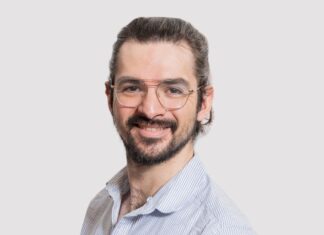Fashion technology scale up Looklet launches product that allows retail customers option to style and mix and match clothes virtually
Please introduce yourself and your startup Looklet to our readers!
My name is Adam Berg – I’m the CEO and co-founder of Looklet, a technology scale-up for fashion retailers’ image production. We offer a photo solution for fashion e-commerce players without models or photographers, ultimately reducing costs and streamlining the e-commerce process. Some of our clients include Saks Fifth Avenue, Holt Renfrew, Fenwick, and Lands End.
How did you get the idea of Looklet?
Some friends (later cofounders) and I cracked it. The original idea was to create a styling tool online where users could combine actual garments with real models, and that original idea is actually coming to fruition now in 2022. We had a feeling that with the rising costs of fashion retail production, there would need to be an option for retailers to streamline the process and digitise as much as possible, without sacrificing the final product’s image quality.
The idea of it as the B2B solution for creating images that is our main focus today grew organically as our licensing customers understood how they could achieve higher quality and save money with our process.
Why did you decide to start with Looklet?
I’ve always dreamt of running my own company, building something great, and being my own boss. My cofounding friends and I noticed that with the rise in e-commerce, retailers needed to amplify their online presence to stand out in the pack. We had a background in fashion, tech, and advertising, so we decided to put our brains together to come up with a new solution. The fashion industry is massive and there are innovations for many problems. However, the actual fashion image production process is, in many cases, very manual, not scalable, and delivers inconsistent results. This is why we wanted to create a solution that different-sized enterprises could benefit from.
What is the vision behind Looklet?
Simply put, we want to be the global first-choice in fashion product imagery. I believe that eventually, image production will be fully digitized, and each consumer will see personalised imagery and can virtually try on their style and fit. Looklet is at the forefront and driving this development.
How difficult was the start and which challenges you had to overcome?
As many startups do, we started in a very dodgy basement with a small group of friends who spent time with each other 24/7 building the first beta version of our product. None of us had deep pockets and we weren’t backed by investors, so a lot of the challenges were obviously around resources and funding. Being broke was the reality for the first few years. We took out new mortgages on our apartments, sold our cars, and cut down on everything possible to fund our idea.
One of my co-founders had a knack for poker, so he spent his few hours off at the casino to finance his living expenses since we didn’t have a salary for quite some time. I wouldn’t recommend poker as a way of funding your living expenses but it is a testament to our dedication. We were young and foolish, we sacrificed family and personal relationships, and took a lot of personal risks. When I look back at that period I’m thankful for all the support I had from my family, and especially my wife who endured living with me through that crazy period.
Another big challenge was to build our hardware.
Our team is software experts but our solution required a new type of hardware to be designed. We managed to solve that by asking a group of industry designer friends to help us out and a local construction firm to make a bet on us. We ended up with a really great beta product and we still work with that local construction firm that took a bet on us all those years ago.
In essence – starting a company is no joke: It is challenging in every way. It’s not glamorous – it’s downright hard work. After a while, you basically become an expert in making mistakes and solving problems, because that is what you deal with all day. But now and then, you manage to make a big leap. It might be signing a new client, managing to convince a fantastic developer to join the team, or releasing something really great product-wise. Those moments and that rush is worth all of that blood, sweat, and tears and that’s why I love doing what I do.
Who is your target audience?
Our target audience is predominantly high-volume, multi-brand retailers, such as Saks Fifth Avenue, Veepee, and Fenwick. While our services are available globally, we primarily focus on Europe and US.
What is the USP of your startup?
We digitise model photography to simplify, optimise, and boost fashion e-commerce photo production. Compared to other photo production options, our solution at Looklet is photorealistic and is consistently and extremely high-quality. We offer beautiful and consistent model imagery for e-commerce at scale, and we do it without models or photographers on set.
Additionally, we can enhance retailers’ e-commerce efforts around the globe. Not only do we shoot and style their garments at an affordable cost and without the need for an elaborate photo production process, but we also make the result look incredibly realistic. We shoot models, digitise them, and put them into the system so our clients can style products the way that is best for their brand. We have actually learned from our clients that they’ve saved 30% – 40% in photo production costs through our services without sacrificing the quality that their end-users, the consumers, deserve.
Can you describe your typical workday?
I get up at 6 am and I hit the gym. Lifting weights is my yoga and I consider it an important part of my workday since it allows me to decompress and get focused for the day ahead. I start up by meeting with the team based in Stockholm. We go over the big projects for the day, chat about priorities, and divide and conquer on all of Looklet. Running a company is balancing strategy with operations, you have to love mixing the two in order to do a good job.
Next, I spend time working on our product. This usually means collecting feedback from our clients and discussing ways to improve together with my cofounder and CPO. We have a huge backlog of things we want to do and when everything is a top priority, nothing is. So, a lot of the time it’s about making tough and sometimes frustrating decisions that are necessary for true prioritisation. The afternoon tends to vary depending on what Looklet is up to at the moment. I try to be as flexible as possible during this time in case I need to touch base with any of our teams around the globe. I have a great and motivated commercial team, but I usually handle or work together with them on some of the larger strategic deals – this means doing demos or crafting presentations, proposals or negotiating contracts.
And I always try to get home at 6 pm, have dinner with my family, and spend time with the kids, my wife, and my dog. I spend a few hours in the evening normally between 9-11p talking to my cofounder going over what happened during the day, checking up on slack and emails, and make a plan of attack for the following day.
Where do you see yourself and your startup Looklet in five years?
A lot can change in five years, but an exciting update that will keep us busy for the foreseeable future is our Dressing Room project, which just launched in May. Dressing Room leverages all of our core image rendering tech here at Looklet, along with our AI and 3D systems to create high-quality and color-accurate imagery. It’s been in the works for some time now and we’re now able to offer the product to retailers – the next version of the Dressing Room will enable the consumer to capture an image and data of themselves directly from their smartphone for styling. We’re predicting a lot of changes in the near future with Dressing Room along with some exciting updates and features.
What 3 tips would you give to founders?
Treat your employees how you would like to be treated: At the end of the day, you are all in it together. Make sure to laugh, have fun, be transparent, show that it’s OK to fail as long as you are going for gold, and make sure to share success. The successes that you share will feel that much better when you’re on great terms with your team and can trust them. I’ve always seen employees as more than colleagues, they are an extended family that you spend an awful lot of time with. Invest in that relationship, it will make your work life so much more rewarding and fun
Understand that success is not linear: Companies have hits and misses all of the time, but it’s not indicative of overall success. Focus on what you want to accomplish, your vision, keep your head down, and work hard. Prepare for a rollercoaster ride and be aware that nothing lasts forever, good and bad – that’s what makes this fun.
Give yourself an occasional break: If you overwork yourself, there won’t be any energy left for anything else and that isn’t sustainable in the long run, especially for a founder. When your body and mind tell you to take a breather or walk, listen.
More information you will find here
Thank you Adam Berg for the Interview
Statements of the author and the interviewee do not necessarily represent the editors and the publisher opinion again.









